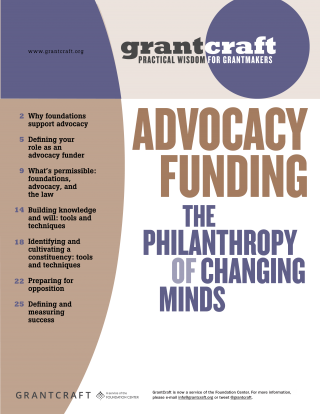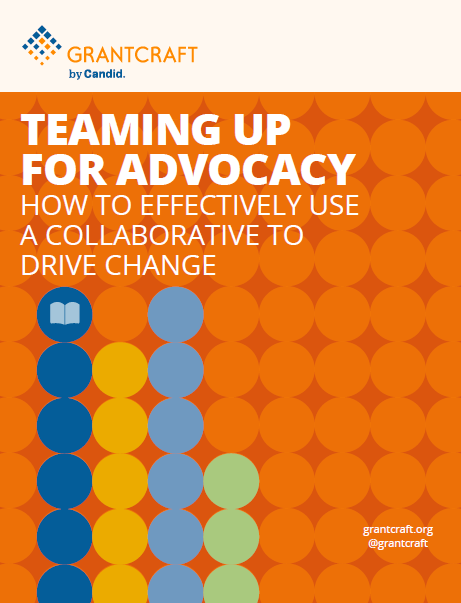Advocacy Funding The Philanthropy of Changing Minds
Grantmakers tend to be cautious about funding advocacy, and for good reason - yet advocacy can play a crucial role in advancing a foundation's mission. In this guide, contributors explain that advocacy includes a lot of opportunities to improve public policy through work that is well within the limits of the law. Whether your purpose is to advance an idea, argue a position, or enrich the policy debate, the guide offers resources and strategies for planning your work, reaching your audience, assessing impact, and more.
Highlights
- What's permissible for foundations
- Working with grantees who lobby
- Building a case, cultivating a constituency
- Preparing for opposition
What's in the Guide?
- Why Foundations Support Advocacy: For foundations, the pursuit of better public policy is often crucial to achieving their fundamental missions. Advocacy can be an important part of the strategy.
- Defining Your Role as an Advocacy Funder: An advocacy strategy needs to match a foundation’s mission, values, and long-term goals. It should also be in alignment with your level of persistence, grant-making style, and tolerance for public attention.
- What’s Permissible: Foundations, Advocacy, and the Law: U.S. federal law prohibits private foundations from lobbying or expressly funding lobbying — that is, promoting a particular position on pending legislation. Yet those restrictions still leave a lot of open territory for grant makers who want to improve public policy.
- Building Knowledge and Will: Tools and Techniques: Grantmakers in advocacy also help to define and describe problems of public concern, and to educate policy makers and their constituents about possible solutions.
- Identifying and Cultivating a Constituency: Tools and Techniques: Advocacy is typically a collaborative effort in which organizations, coalitions, or movements deliver their message to the wider public. Organizing people and groups that share a common interest and a determination to make change may therefore be part of the task.
- Preparing for Opposition: When Advocacy Meets Resistance: When advocacy comes up against opposition, the options for action are not solely to attack or retreat. Success may depend on striking the right balance between confrontation and negotiation, resistance and engagement.
- Defining and Measuring Success: One common fear that keeps grantmakers from funding advocacy is that success is hard to measure. In this section, grantmakers offer approaches to assessing advocacy work.

Categories
Content type
Strategies
Content series
- Link to Does Size Matter?
-
Link to Does Size Matter?
Why Foundations Support Advocacy
Many people believe that private foundations are prohibited from funding advocacy — and there are, to be sure, some kinds of advocacy that are legally impermissible. But these are few and relatively easy to avoid. “I don’t think the principal constraints are legal ones,” said one grantmaker, reflecting on attitudes he encounters in the field.
Read more -
Link to Does Size Matter?
Choosing a Strategy
Among the earliest choices facing grantmakers in advocacy - and a question that may recur many times - is how an advocacy campaign should be organized: What kind of activity, involving what kinds of relationships among people, will drive the effort for change?
Read more -
Link to Does Size Matter?
Advice from Grantseekers
It's not necessary - and it's often counterproductive - to expressly forbid lobbying in grant letters. Unless a particular grant specifically requires "expenditure responsibility" or the grant might appear to have funds "earmarked" for lobbying, there is no reason why grant letters should forbid activities that are perfectly legal for the grantee and that are not the responsibility of the funder.
Read more -
Link to Does Size Matter?
Levels of Advocacy Operation Individuals, Organizations, Collaboratives or Networks?
Mobilizing individuals directly may be the easiest approach to understand, but it’s usually the hardest to accomplish. To stir individuals to carry out or advocate for change directly, it may be necessary to apply mass media in a sufficiently sustained and concentrated way to reach thousands or millions of people with a persuasive message.
Read more -
Link to Does Size Matter?
Advocacy Controversy
The presence of controversy and the possibility of confronting opposition are not reasons to avoid advocacy. In fact, they may be the most important reason to engage in advocacy — given adequate precautions. Grantmakers emphasize that confronting opposition and negotiating an effective compromise are not necessarily opposite alternatives.
Read more -
Link to Does Size Matter?
Approaches to Evaluating Advocacy
Types of Advocacy Evaluation:
- Process Evaluation - intended mainly to determine whether the campaign resulted in the activities and products that were expected of it. This is the most basic kind of evaluation for any grantmaking effort.
-
Link to Does Size Matter?
What Grantees Wish Funders Knew about Advocacy Funding
- It’s not necessary — and it’s often counterproductive — to expressly forbid lobbying in grant letters.
- General support grants are a useful way to support public policy work while minimizing legal risk to the foundation.
-
Link to Does Size Matter?
Why Evaluate an Advocacy Effort?
Despite the difficulties of measuring the effectiveness of an advocacy effort or pointing to the difference made by a particular activity or grant, one experienced advocacy grantmaker argued that there are other rationales for supporting an evaluation:
Read more -
Link to Does Size Matter?
Preparing for Opposition When Advocacy Meets Resistance
Balancing Negotiation and Confrontation: One grantmaker in civil rights described her view of opposition and negotiation this way: “My portfolio was a constant combination of battle and negotiation, but the most successful work, I would say, amounted to negotiation with a very high tolerance for confrontation.
Read more
Grantmakers tend to be cautious about funding advocacy, and for good reason - yet advocacy can play a crucial role in advancing a foundation's mission. In this guide, contributors explain that advocacy includes a lot of opportunities to improve public policy through work that is well within the limits of the law. Whether your purpose is to advance an idea, argue a position, or enrich the policy debate, the guide offers resources and strategies for planning your work, reaching your audience, assessing impact, and more.
Highlights
- What's permissible for foundations
- Working with grantees who lobby
- Building a case, cultivating a constituency
- Preparing for opposition
What's in the Guide?
- Why Foundations Support Advocacy: For foundations, the pursuit of better public policy is often crucial to achieving their fundamental missions. Advocacy can be an important part of the strategy.
- Defining Your Role as an Advocacy Funder: An advocacy strategy needs to match a foundation’s mission, values, and long-term goals. It should also be in alignment with your level of persistence, grant-making style, and tolerance for public attention.
- What’s Permissible: Foundations, Advocacy, and the Law: U.S. federal law prohibits private foundations from lobbying or expressly funding lobbying — that is, promoting a particular position on pending legislation. Yet those restrictions still leave a lot of open territory for grant makers who want to improve public policy.
- Building Knowledge and Will: Tools and Techniques: Grantmakers in advocacy also help to define and describe problems of public concern, and to educate policy makers and their constituents about possible solutions.
- Identifying and Cultivating a Constituency: Tools and Techniques: Advocacy is typically a collaborative effort in which organizations, coalitions, or movements deliver their message to the wider public. Organizing people and groups that share a common interest and a determination to make change may therefore be part of the task.
- Preparing for Opposition: When Advocacy Meets Resistance: When advocacy comes up against opposition, the options for action are not solely to attack or retreat. Success may depend on striking the right balance between confrontation and negotiation, resistance and engagement.
- Defining and Measuring Success: One common fear that keeps grantmakers from funding advocacy is that success is hard to measure. In this section, grantmakers offer approaches to assessing advocacy work.



